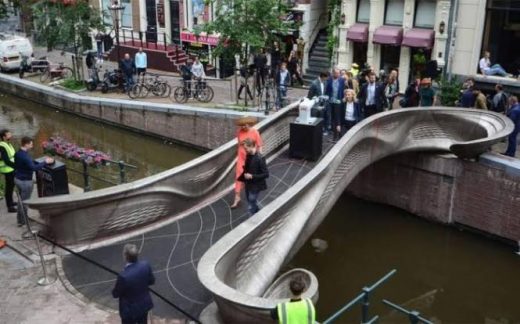Introduction:
This is a 3D-printed steel bridge that was opened to the public in Amsterdam in July 2021. The bridge was developed by a Dutch Robotics Company named MX3D, in collaboration with a consortium of experts. The bridge will represent a major milestone for 3D printing technology.

Fig 1: The first 3D printed steel bridge unveiled in Amsterdam
About the Bridge:
The steel bridge is 12 meters (40ft) in length and having the weight of 4.9 tons. As experts said, it will act as a “living laboratory” that will capture and transmit data on its health in real-time to show how it changes over its lifespan. A smart sensor network is installed in the bridge and it is designed by a team from the Alan Turing Institute. The sensor attached is used to gather data on air quality, temperature, strain, displacement, and vibration of the bridge. The data will be analysed by a computer model, “digital twin” of the bridge and it will emulate the actual bridge’s in real-time. It will help to improve the accuracy of the bridge.
Construction of the bridge:
The bridge was fabricated from stainless steel rods by six-axis robotic arms and equipped with welding gear. The designers first created the concept of the bridge in 2015 to make an exceptionally efficient structure that will also emphasize both safety and simplicity. They have tested and simulated the structure and its components throughout the printing process. And now the researchers will analyze the data in real-time to monitor how it behaves with foot and cyclist traffic. It took four years to complete the construction process. For construction of the bridge, the machines laid out 10,000 pounds of steel, heated to 2,732 degrees Fahrenheit in an intricate layering process.
3D printing presents vast opportunities for the construction industry. It provides greater freedom in terms of material properties and shapes. It also brings a number of challenges that require structural engineers to think in new ways. 3D printing becomes a major technology in engineering and it needs to develop appropriate approaches for testing and monitoring to realize its full potential. 3D printing can accelerate the infrastructure design process when couples with digital twin technology. The outcome results in the optimal design process and efficient structures with respect to environmental impact, architectural freedom, and manufacturing costs. If the bridge works properly as expected, it could be a blueprint for fixing our own structurally deficient infrastructure.
If you have a query, you can ask a question here.


